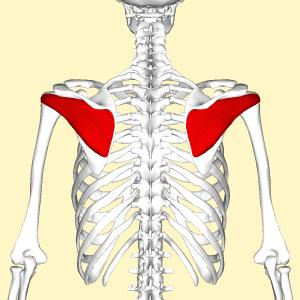The Brookbush Institute Announces a New Course: Infraspinatus and Teres Minor
Everything you need to know: attachments, innervation, actions, palpation, arthrokinematics, fascial integration, postural dysfunction, interventions, and more.
Additional Rotator Cuff Courses
- Supraspinatus
- Subscapularis
STRUCTURE
This course describes the anatomy and integrated function of the infraspinatus and teres minor of the rotator cuff muscles (a.k.a. the shoulder external rotators, glenohumeral joint rotators, or SITS muscles). As the name implies, the infraspinatus originates inferior to the spine of the scapula in the infraspinous fossa of the scapula (shoulder blade), and the teres minor muscle is the smaller of two "teres muscles", the other being the "teres major ." The teres minor originates superior to the teres major on the superior 2/3rd of the lateral border of the scapula. Both the infraspinatus and teres minor cross the glenohumeral joint (shoulder joint), and both tendons insert into the greater tubercle of the humerus. The fascia covering the infraspinatus is known as the "infraspinatus fascia." Although the fascia is tacked firmly to the borders of the scapula, medially it continues to invest in the fascia superficial to the rhomboids, superiorly it invests in the fascia superficial to the supraspinatus (deep to the upper trapezius ), and laterally layers envelop the teres minor (coursing under the deltoid and separating the teres minor from the teres major ), as well as more superficial layers coursing into the deltoid fascia. Research suggests the infraspinatus and teres minor are moderately sized muscle groups, contributing to approximately 5.9% (4.8% infraspinatus and 1.1% teres minor) of the total upper body muscle mass (for comparison, the pectoralis major contributes approximately 10% of the upper body mass). Additionally, research suggests that the infraspinatus and teres minor are composed primarily of type II muscle fibers.
FUNCTION
The infraspinatus and teres minor muscles both cross the shoulder (glenohumeral) joint and are likely the prime movers of shoulder external rotation. Additionally, both muscles aid in the stabilization of the shoulder during all joint actions as part of the rotator cuff. This course also discusses the contribution of the infraspinatus and teres minor to shoulder joint arthrokinematics, fascial integration, subsystem integration, and postural dysfunction. For example, "Arms Fall " during an Overhead Squat Assessment is correlated with altered rotator cuff recruitment and extensibility, including a reduction in EMG activity, a reduction in range of motion (ROM), and a reduction in shoulder stability, strength, and power. These changes imply these muscles most often should be activated and/or strengthened.
PRACTICAL APPLICATION:
Sports medicine professionals (personal trainers, fitness instructors, physical therapists, massage therapists, chiropractors, occupational therapists, athletic trainers, etc.) must be aware of the integrated function of the infraspinatus and teres minor for the detailed analysis of human movement, and the development of sophisticated exercise programs and therapeutic (rehabilitation) interventions. For example, altered activity and length of the infraspinatus and teres minor may contribute to rotator cuff injury, rotator cuff tears, shoulder pain, shoulder impingement syndrome (SIS), supraspinatus tendon strain, biceps tendon impingement, and the resulting weakness and pain during motions such as shoulder abduction and flexion. Altered infraspinatus and teres minor activity is also correlated with an increase in supraspinatus and subscapularis activity. These changes in shoulder function are likely to result in a significant reduction in upper extremity speed, agility, and strength, and a reduction in the effectiveness of resistance training intended to improve upper body strength and hypertrophy (bodybuilding). Deeper knowledge of infraspinatus and teres minor anatomy is essential for optimal assessment, intervention selection, and building a repertoire of infraspinatus-specific techniques.
THIS COURSE INCLUDES:
This course also provides detailed descriptions of etymology, attachments, innervations, joint actions, location, palpation, integrated actions, arthrokinematics, fascial integration, subsystem integration, postural dysfunction, assessment, clinical implications, and interventions.
- Webinar
- Study Guide
- Text and Illustrations
- Audio Voice-over
- Research Review
- Technique Videos
- Case Study and Sample Routine
- Practice Exam
- 3 Credit Final Exam
Brent Brookbush
Brookbush Institute
email us here
Visit us on social media:
Facebook
X
LinkedIn
Instagram
YouTube
TikTok
Legal Disclaimer:
EIN Presswire provides this news content "as is" without warranty of any kind. We do not accept any responsibility or liability for the accuracy, content, images, videos, licenses, completeness, legality, or reliability of the information contained in this article. If you have any complaints or copyright issues related to this article, kindly contact the author above.

